Interactive Marketing Guide [Definition, Examples & More]
It wouldn’t be a stretch to say that most content on the internet is static. Brands bet on blog posts, guides, case studies, and other similar content types to boost engagement and reach new potential customers. However, it doesn’t always work, and you can’t always blame poor SEO for it.
Sometimes, your target audience simply wants your content to be more actionable. People want to create their own experiences with it, and interactive marketing is what can help you bring these experiences to them,
This guide will introduce you to interactive marketing, its history, best practices, and examples.
Ready?
Let’s dive in.
P.S. If you’re just about to build your first content marketing strategy, make sure to check out our guide – it has everything you need to know to get started.
What Is Interactive Marketing?
Interactive marketing (a.k.a. trigger-based or event-based marketing) is a form of marketing focused on building a two-way consumer-brand communication based on consumers’ actions, behaviors, needs, preferences, demands, etc.
Let’s explain this definition in simpler terms. Think about how brands usually handle their campaigns – typically, it’s a one-way stream of content, where a business sends a message, and consumers receive it. There’s nothing wrong with this approach – it works fine, but it often lacks personalization.
In its turn, interactive marketing enables two-way interactions, where consumers directly tell you about your preferences. Using this data can help you personalize your offer, optimize the feedback loop, and improve your campaign’s performance altogether.
Now, let’s take a closer look at personalization and other benefits of interactive marketing.
Why Is Interactive Marketing Important?
So, we’ve established that interactive marketing is important because it allows you to make customized offers based on consumers’ personal preferences. As a result, your campaigns attract more of your audience’s attention – reportedly, interactive content drives two times more engagement than static content.
The way interactive content works also has a positive impact on brand awareness. This content type is usually highly helpful to the consumer as it can potentially solve a certain problem (e.g., a BMI calculator to help a person control weight). If it does, the consumer will remember the brand and think about it the next time they face the same issue.
If we follow the same logic, we can come to the conclusion that interactive marketing can also help you retain customers. Since you’ll be making content that’s not just educational but also provides practical value and allows customers to express their needs, they will be more likely to return to you rather than look for a replacement.
By the way, interesting fact – according to Outgrow, interactive content is 93% effective at educating prospects, while the effectiveness of static content in this regard is at 70%. And, interactivity makes content 88% more noticeable. So, if you’re currently struggling with improving brand recognition or generating leads, consider replacing your static content with interactive.
Now, let’s learn more about the origins of interactive marketing.
The History of Interactive Marketing
Alright, let’s take a journey back in time and see how interactive marketing first came to be. Take a look at this graph representing the historical timeline. As you can see, the history of interactive marketing is brief but quite eventful:
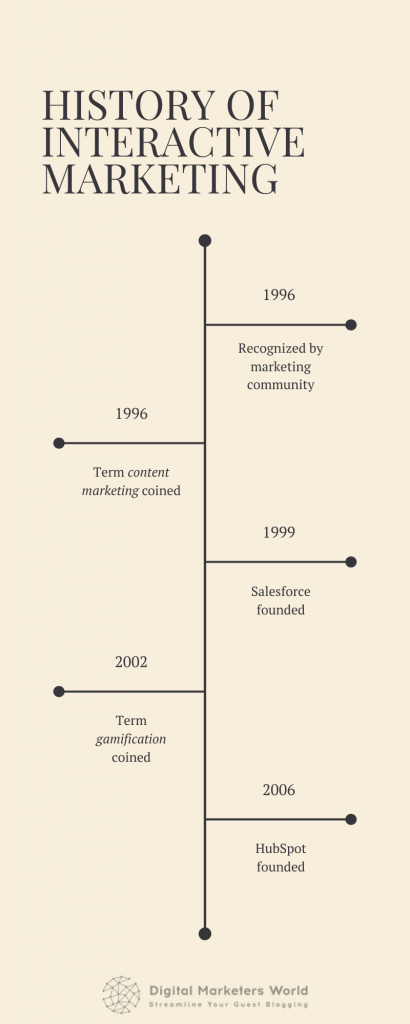
Interactive marketing appeared as a response to the classic marketing theory and the 4P (product, price, place, and promotion) approach, according to which a brand should direct all efforts at convincing a consumer to buy a product. However, since the fast development of economic systems and mass production, the attention went from simply selling the product to establishing long-term relationships with clients.
According to Harvard Business Review, the first time the marketing community recognized interactive content as the future of digital advertising and eCommerce was in 1996. Such conclusions were made as a result of a conference organized by 80 people from Harvard Business School.
The main point of view conference participants put forward was that content was not the king; communications were. Content should be viewed not as a means to sell but as a way of enabling communication between a customer and a brand. By the way, the same year this conference took place, John Oppedahl coined the term content marketing at a journalism conference.
The response to this change of heart in the marketing world came quickly when Salesforce was founded in 1999. Its product allowed marketers and salespeople to interact and guide prospects through the CRM in real-time, thus enabling two-way communication – the prerequisite for interactive marketing.
Speaking about interactive marketing, we also have to mention gamification, which, in marketing, means borrowing elements of games to attract potential customers and retain them. Gamification as a term appeared in 2002 when Nick Pelling was working on designing the user interface for commercial electronic devices. The concept of gamification laid the foundation of how modern software UI is developed, and it also became one of the elements enabling content interactivity.
Finally, we also can’t forget about the launch of HubSpot in 2006, which became one of the major players in customer relationship management and platforms for content marketing, helping brands create and run interactive content campaigns as well.
So, these are all the events that went into the making of interactive marketing as we know it. With technological advancements and the birth of CRM and automated marketing tools, marketers got an opportunity to run interactive marketing campaigns and build long-lasting relationships with customers.
Now, let’s quickly sum up all advantages and disadvantages of this strategy before going over the eight most common forms of interactive marketing.
Advantages and Disadvantages of Interactive Marketing
We’ve already mentioned some interactive marketing benefits a bit earlier when talking about the importance of this strategy. The main goal is personalization and letting the customer have their say.
However, as with all marketing strategies, using the interactive approach also has its disadvantages. We’ve put all the pros and cons in this handy graph, take a look:
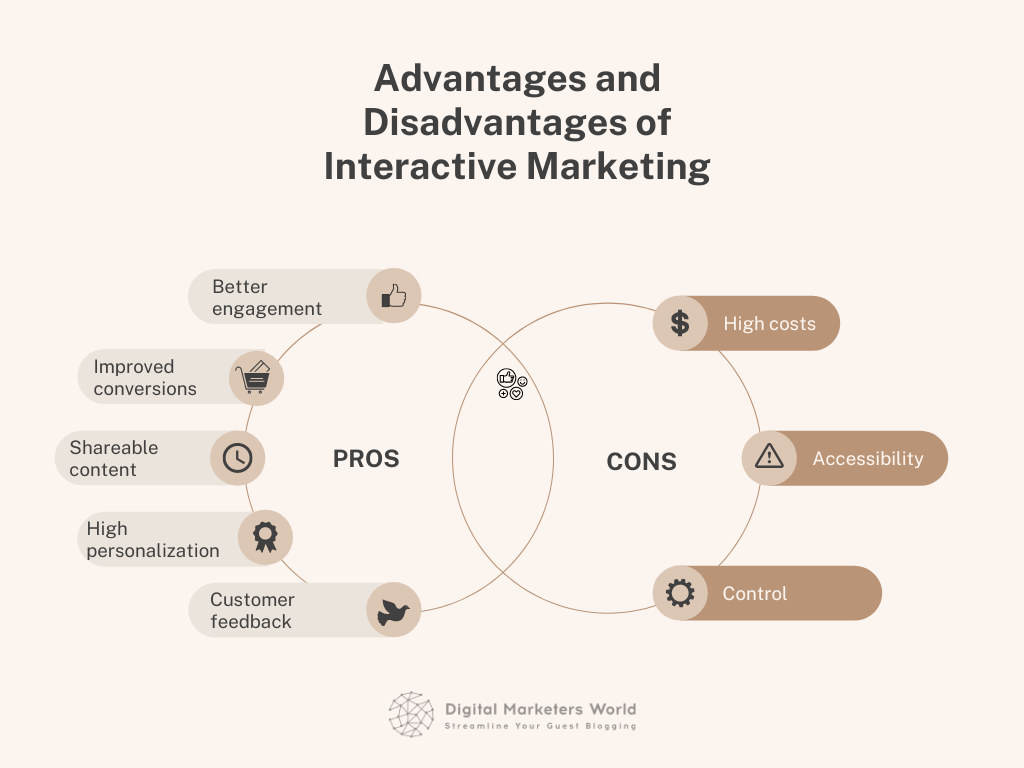
Now, let’s add a bit of commentary to help you form an objective opinion of interactive content marketing.
Advantages of interactive marketing
Building long-lasting relationships with consumers based on trust should be every brand’s priority. If you succeed at building such relationships with your customers, you’ll also be able to enjoy higher sales and improved brand awareness.
Interactive content helps you achieve this goal, bringing along the following benefits:
- Better user engagement: 66% of brands agreed that their customer engagement increased after they started implementing interactivity in their content strategies. The reason for this is simple – interactive content answers the target audience’s interests. Also, this content involves multiple senses at the same time, helping people learn faster.
- Improved conversions: consumers are more likely to buy your product after seeing it featured in interactive content. In particular, if we take shoppable marketing videos, a study shows that 67% of consumers would purchase a product after consuming this content.
- Share-worthy content: interactive content is very unique, and that’s what prompts people to reshare it. Statistics confirm this fact: 77% of marketers recognize high reusability and shareability of this content, bringing repeat visitors and multiple exposures.
- Personalization: when interacting with this content type, consumers create their own personalized experiences according to their needs and preferences. As a result, they get an offer that is perfectly tailored to their demands.
- Getting feedback: interactive content helps consumers tell about their needs directly. This is the best way to collect customer feedback as it doesn’t impose anything on your target audience.
It’s also important to add that incorporating interactive content in your digital marketing strategy can improve your search engine optimization efforts. In particular, according to the Google Trends report, brands producing shoppable content will be able to enjoy better visibility in SERPs.
What are the disadvantages of this strategy?
Let’s take a look.
Disadvantages of interactive marketing
One major problem businesses might face with interactive marketing is its costs. If you’re running your marketing strategy on a shoestring budget, hiring a developer to work on and improve the functionality of content’s UI and a team of marketers to put together an interactive marketing campaign might cost you a pretty penny (depending on your appetites, of course).
There are a couple more disadvantages you should consider:
- Accessibility: if you use interactive content in a PPC ad, the chances are that many people whom this ad is targeting have already seen it and purchased your product. So, to avoid this, you might need to adjust the audience you want to reach with your ad.
- Control: you are risking falling into the trap of becoming a people-pleaser. Since interactive marketing focuses on taking your audience’s needs as the primary concern, your brand can lose its identity, and your campaigns can become faceless and bland. So, it’s crucial to find a balance between catering to the customer’s needs and promoting your brand.
With the pros and cons clear, let’s review eight content types you can use in your interactive marketing campaign.
8 Types of Interactive Marketing
Interactive content comes in many types and varieties, but we’ve put together a list of the most popular ones – take a look at them:
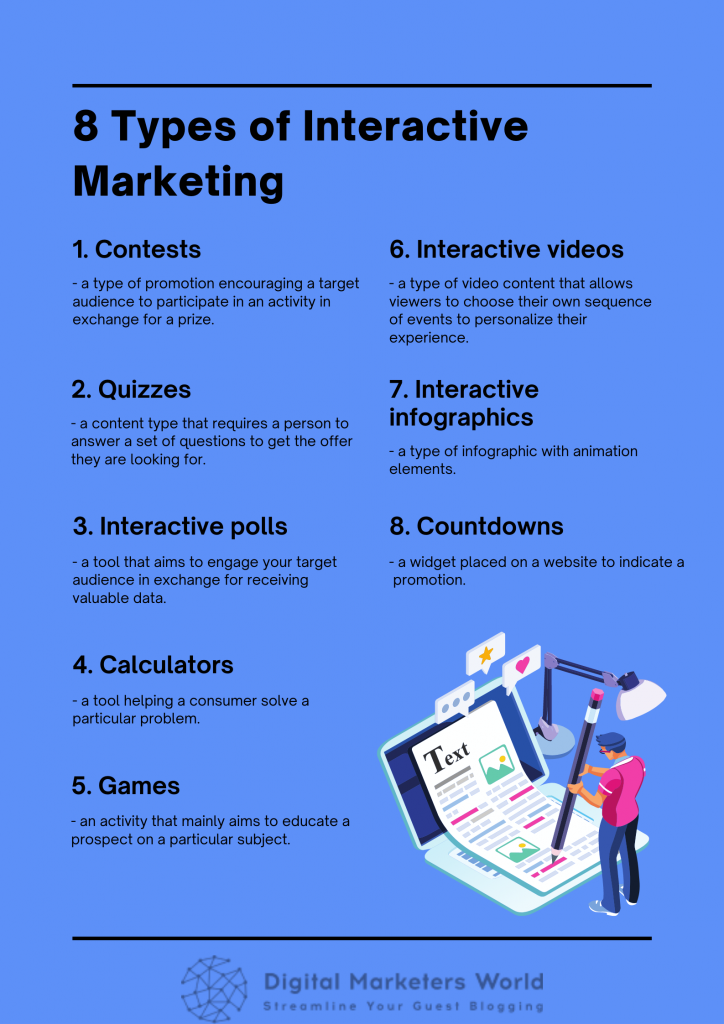
Now, let’s discuss these interactive content types in detail and view some examples.
Type #1: Contests
An interactive contest is a type of promotion encouraging a target audience to participate in an activity in exchange for a prize. You can employ this tactic to increase engagement and attract new leads.
Interactive contests can take many forms, the simplest of which is the spin-the-wheel website pop-up. Here’s a good example from Luxy Lemon:
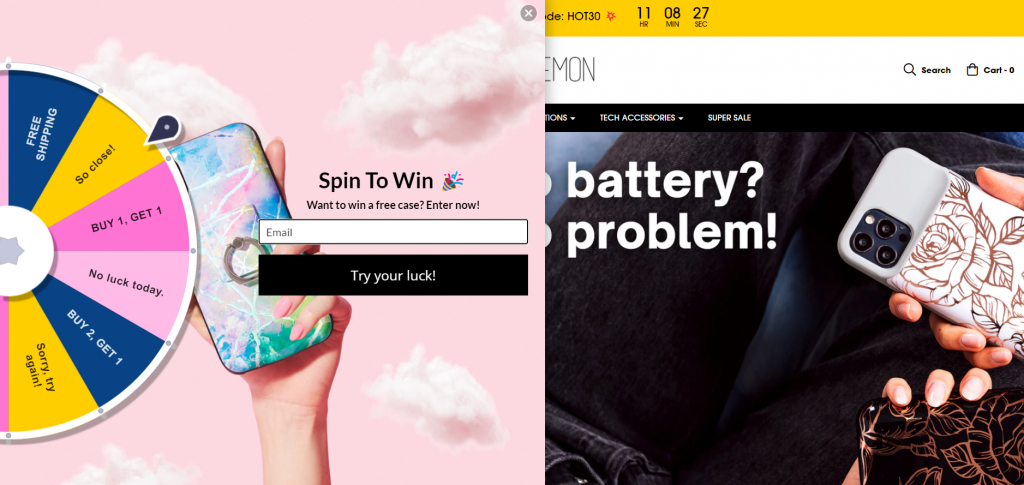
The mechanism here is simple – a visitor comes to your site, sees the pop-up with a few exciting perks, spins the wheel, and gets a chance to win a product or a lucrative discount. If you’re trying to optimize your lead generation strategy, this type of content can work wonders.
Now, let’s take a look at what quizzes can bring to the table.
Type #2: Quizzes
An interactive quiz is a content type that requires a person to answer a set of questions to get the offer they are looking for.
You can use quizzes for two purposes: to boost brand awareness through entertainment or help customers find the right products for their needs. Women.com has a great example of entertainment quizzes (by the way, this website holds the first place for hosting this content, having outcompeted even Buzzfeed):

Adding such content to your website is not obligatory but can help engage more visitors. And, if your business offers a wide variety of products, you can create a quiz helping a consumer find exactly what they are looking for. This example from Eyeko perfectly illustrates what we’re talking about:
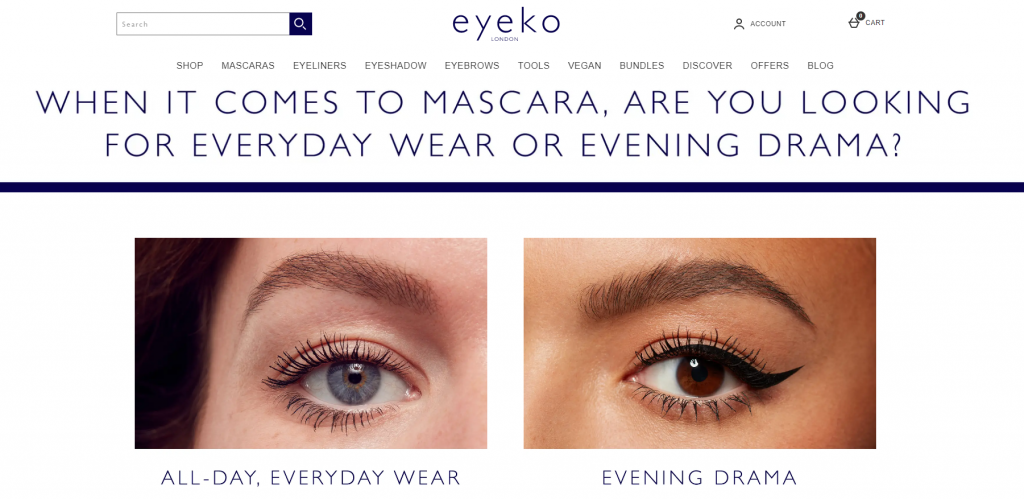
This quiz allows Eyeko website visitors to choose the right mascara product to achieve specific goals. It focuses on the customer’s preferences, personalizing the final product offer.
Next on the list are interactive polls, let’s take a look.
Type #3: Interactive polls
An interactive poll serves the same purpose as quizzes in that they aim to engage your target audience in exchange for receiving valuable data.
How can this data help you?
For example, it can show you which products your customers prefer the most and work on personalized offers. Blue Apron launched a series of interactive polls on Instagram specifically to collect data for this purpose:

By the way, Instagram polls are the best way to engage your audience without investing a lot in developing interactive content from scratch. You can occasionally run such polls to understand your target audience’s attitude towards your products or to simply boost engagement among your followers on social media platforms.
Let’s take a look at some more interactive marketing tactics.
Type #4: Calculators
An interactive calculator is a tool helping a consumer solve a particular problem. You can use calculators at any sales funnel stage to make the customer experience fully customized.
Brands can create these interactive tools to serve a variety of purposes depending on the needs of their target audiences. Let’s say you own a marketing automation platform that allows its users to run online ads. To help them assess the resources they will need to invest in such a campaign, you could create an ad ROI calculator, as HubSpot did for its users:
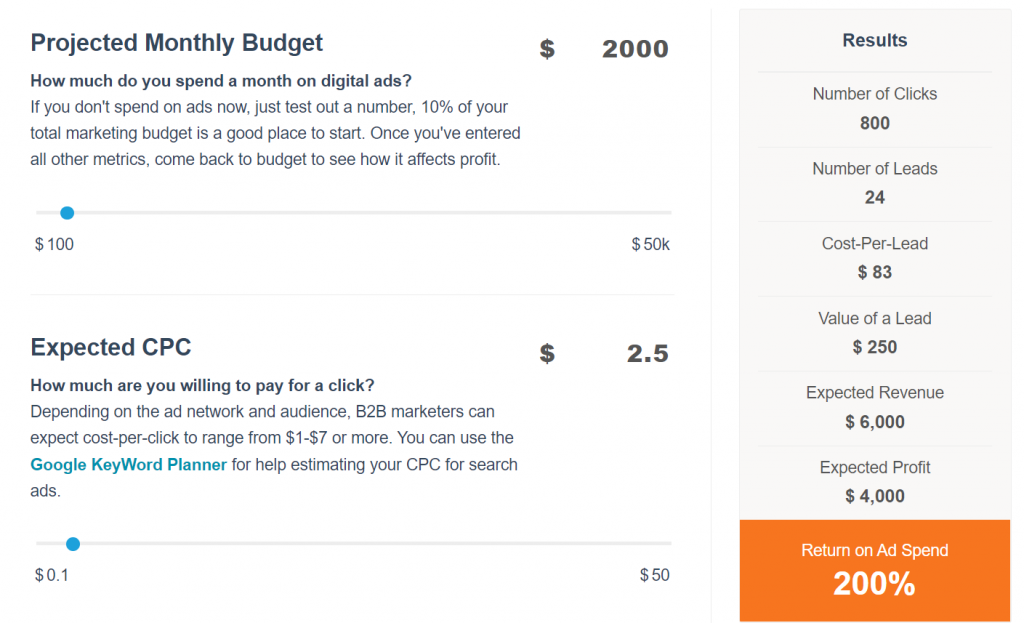
Essentially, this calculator asks a user to answer a few questions, and the tool will tell an estimated number of clicks, leads, CPL, the value of a lead, expected revenue, profit, and overall ROI. These results can help marketers better understand the prospects of running online ads.
Next on our list of interactive marketing strategies are games, let’s take a look.
Type #5: Games
An interactive game is an activity that mainly aims to educate a prospect on a particular subject. Brands can use this interactive marketing tactic to introduce a potential customer to their product, help them learn something new, or, in a broader sense, establish themselves as an education and thought leader in their industry.
A great example of an interactive game is a video by Banqer, the brand we featured in our article on 11 actionable content marketing tips. This video, in particular, teaches you to manage your financial risks:
This content type involves gamification (and so do interactive videos), which also helps convert leads into customers at a faster rate. In fact, according to statistics, companies that invest in gamifying their marketing activities enjoy a 7x higher conversion rate compared to others. So, this content is definitely worth investing in.
Speaking about gamification, some brands also invest in branded apps that use augmented reality. For instance, IKEA developed an application where you can view its products in 3D:

Users can interact with the products in this app and see how they’d look in different home designs.
Now, since we mentioned interactive videos, let’s talk about them next.
Type #6: Interactive videos
An interactive video is a type of video content that allows viewers to choose their own sequence of events to personalize their experience. This interactive marketing strategy also mainly has an educational nature and should absolutely be included in your video marketing strategy.
You can apply interactive videos to all kinds of situations, and they can serve multiple purposes. For example, you can create such content for the recruitment process to find the best candidates to fit your team, as Deloitte did with its Will you fit in Deloitte video:

This video is a series of choices, and when the viewer makes the right decision, the video tells them that the personal quality behind their choice will help them fit in the company well. If the viewer passes through the video successfully, they will get a chance to learn about different departments they can join.
Two more interactive marketing techniques are left on our list. Let’s continue.
Type #7: Interactive infographics
An interactive infographic is a type of infographic with animation elements. Its goal is to present data that would otherwise be hard to read or is too big to put into one simple image. You can add an infographic in other content types as well, for instance, while making a presentation which has to include tons of data.
Every infographic has an educational purpose. It can either be product-related; in this case, it’s intended either for internal company use or for your existing customers. Apart from that, you can also create an infographic to educate the general public on a specific issue. For instance, BBC came up with one showing people whether their jobs will be taken away by robots or not:

Infographics also have high shareability; that’s why 85% of B2B marketers add them to their content marketing and lead generation strategies. You can also turn some of your case studies, white papers, and other original research into an infographic – it can significantly improve your brand’s online visibility.
Now, onto our last interactive content type.
Type #8: Countdowns
An interactive countdown is usually a widget placed on a website to indicate a promotion. Brands often use this strategy to spark interest in their products, attract potential customers, and increase sales.
This countdown on FashionNova’s website perfectly illustrates the purpose of this content:
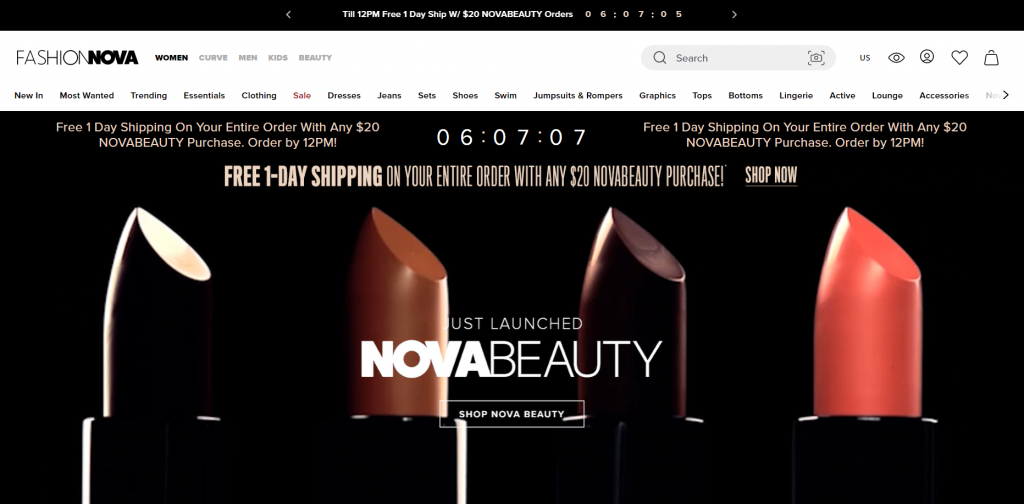
In this case, you can see a countdown inviting customers to enjoy a promotion of one-day shipping on all orders. The offer is limited in time, hence the countdown. You can also use this content type to promote your upcoming product collection to ignite the interest of your audience and potentially boost sales.
Now that you have a better understanding of the content types interactive marketing involves, let’s see what you can do to get the best results from your strategy.
Interactive Marketing Best Practices
As you already know, interactive marketing can be extremely effective in helping you achieve success in various marketing activities. However, we also mentioned that developing some interactive content types can be pretty expensive. For instance, an interactive video alone will require months of work and great investments.
So, to help you ensure that your efforts pay off, we’ve put together a list of best practices to help you navigate interactive marketing with ease.
1) Personalization is a must
Interactive content and personalization go hand in hand. Through it, your target audience can create customized experiences, and 90% of U.S. consumers find it very appealing.
However, if you use interactive content in ads or decide to involve it in marketing campaigns, make sure it reaches the right people. As we mentioned, since this content can deliver more reach and engagement, there is a high chance that a part of an audience you’re targeting with an ad campaign has already seen it and bought your product. So, personalize your campaigns and the interactive content they involve to reach new prospects.
Now, let’s see what exactly you can do to customize your content better.
2) Customer segmentation
Audience segmentation is the most effective tactic to add more personalization to your marketing campaigns. We’ve talked about it in more detail in our email marketing guide.
This tactic can also help you create relevant content for a specific part of your audience. For instance, if you want to re-engage dormant customers or boost activity among your existing clients, you can send them an email with an interactive poll:
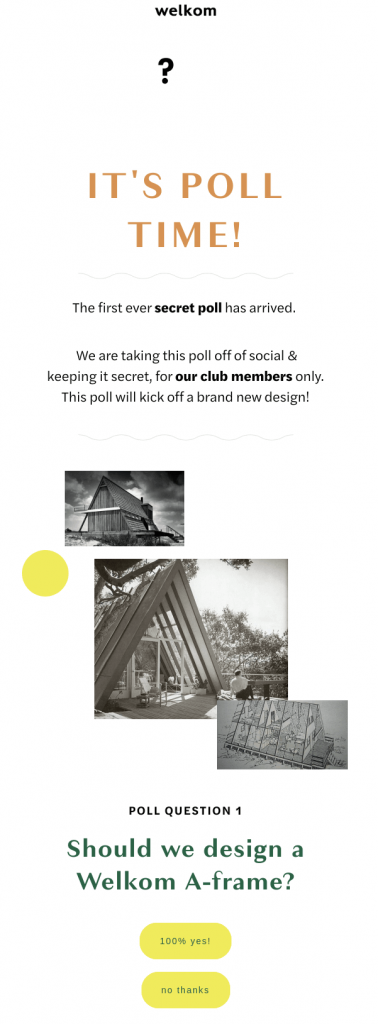
We recommend studying the metrics, such as demographic data and behaviors of different audience segments first before choosing the type of interactive content. For instance, if they were responsive to polls and surveys before, it’s logical to use these content types to reach them again.
Next, let’s talk about one of the most important features your content should include.
3) Provide incentives
In other words, allow your target audience to take initiative and create their own experiences when interacting with your content. This way, your interactive content will be truly personalized.
However, it doesn’t mean you should adopt a laissez-faire attitude and let your target audience go with the flow. Remember – your interactive content should serve a specific purpose, so the choices offered by it should guide consumers to a specific conclusion. Banqer’s content mentioned before is an excellent example of this – there is very specific knowledge that its target audience should take from its video, and the sequence of choices in the video guides the viewers to it.
Now, off to the next step.
4) Technology is your ally
If you decide to add interactive content to your marketing strategy, it’s not necessary to hire a developer to make it, go through digital marketing training, or partner with a marketing agency. Indeed, some interactive content types are more labor-intensive than others, but if you make friends with content marketing solutions and new technologies, you can do half the work by yourself.
For instance, if you want to create an infographic, there’s no need to hire a designer for it. There are data visualization tools like Google Charts, Chartist.js, Infogram, etc., which can help you with that. For surveys and polls,there are quiz-building apps such as Interact, Outgrow, and Survey Monkey. On many of these platforms, you can create surveys for free without adding credit card details. If you plan to create quizzes on an ongoing basis, investing in an automation tool would lift a huge load off your shoulders and make the content creation process easier.
Now, let’s see how you can further improve your interactive content.
5) Harness the power of storytelling
Everyone likes a good story, especially if it’s relatable. Marketing messages through such stories are 22 times more memorable because they involve an emotional component that resonates with the target audience.
So, study your audience’s interests and use them to tell relatable stories through your interactive content. Again, Banqer’s example fits perfectly here – the brand recognizes that its target audience may have problems managing financial risks, so it films an interactive storytelling video that guides them through different choices. These choices resonate with the viewers because they might have made them earlier. So, don’t dismiss storytelling during the content creation process – it can significantly boost reach and engagement.
3 Great Interactive Marketing Examples
Now, to conclude our guide to interactive marketing, let’s take a look at three more examples of different brands successfully implementing it.
Let’s dive in.
Example #1: Thinkful’s Career Quiz
Thinkful, a tech education platform by Chegg, has developed an interactive career quiz to help future learners make the right choice:
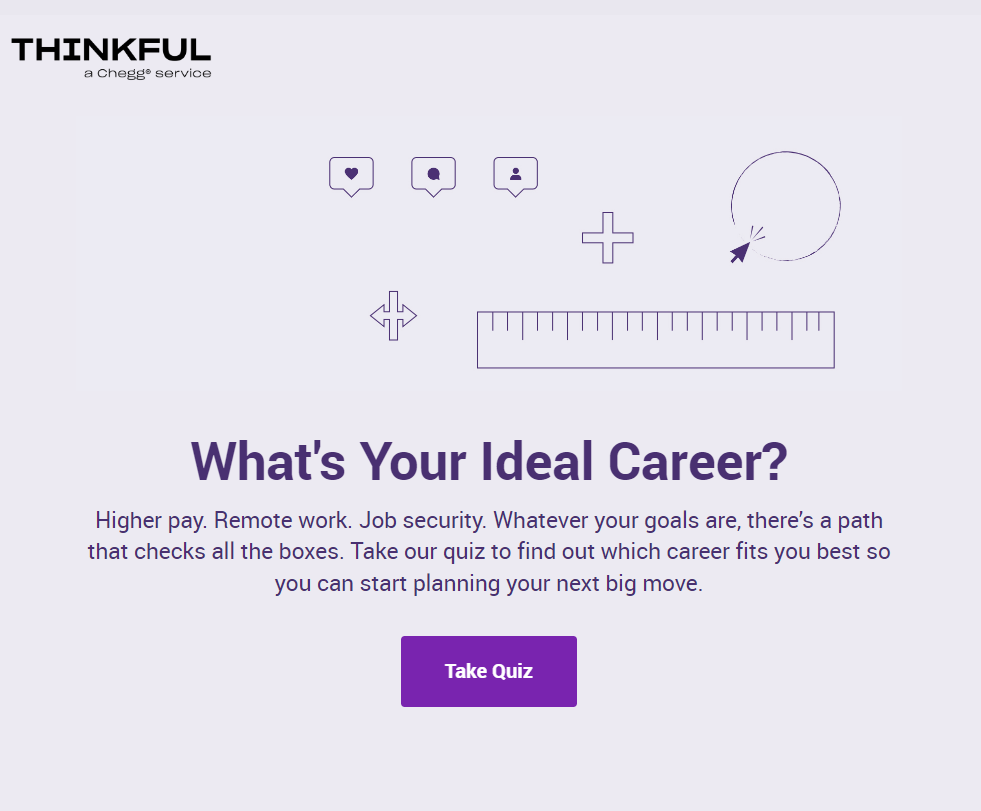
This quiz asks you about your personal qualities, favorite activities, how you make decisions, your preferred way of working, and what you picture yourself doing at your perfect job. Eight questions later, and you have the best career in tech selected for you.
Thinkful uses this quiz as a lead magnet to attract more learners to its platform. You can do the same with your content, and if you have trouble coming up with ideas, make sure to check out our lead magnet guide.
The next interactive content example is beyond creative, let’s check it out.
Example #2: This Beautiful Interactive Video from BBC Scotland
This video from BBC Scotland takes us on a trip around Glen Coe, one of the most spectacular places in the Highlands. It tells you a fascinating story of its origins, landscape, and motion pictures it was featured in:
The video has a 3D effect – you can spin the screen to see the scenery in 360 degrees. It’s an excellent idea for a creative interactive video that can boost engagement and attract new audiences.
Now, let’s see what IBM has come up with.
Example #3: IBM’ Think City
If you’re planning to make a report, why not turn it into an interactive one? That’s what IBM did to show its impact across different industries:

When you pick an industry, it shows you various technologies IBM has developed and why they are important for that industry. You can also watch a short video of those innovations in action:

Indeed, it’s a perfect solution if you have an extensive amount of data and want to structure it. Besides, such content is highly shareable, so investing in it will definitely pay off.
Over to You
Interactive content marketing offers a wide variety of unique ways to get new customers, boost sales, improve engagement, and establish your brand’s authority as a thought leader in your industry. This strategy is also governed by several best practices, following which can help you achieve greater results. Let’s recap these practices:
- Bet on personalization
- Segment your target audience for better reach
- Provide incentives
- Use technology to create interactive experiences
- Incorporate relatable stories in your content
Hopefully, our guide will encourage you to invest in interactive marketing and guide you on your journey to building a successful strategy. And, if you’re interested in more articles like this, make sure to check out our blog.

Mariia is a content strategist and editor at Digital Marketer’s World. She is passionate about educating others on all things marketing and believes in the power of the written word.
